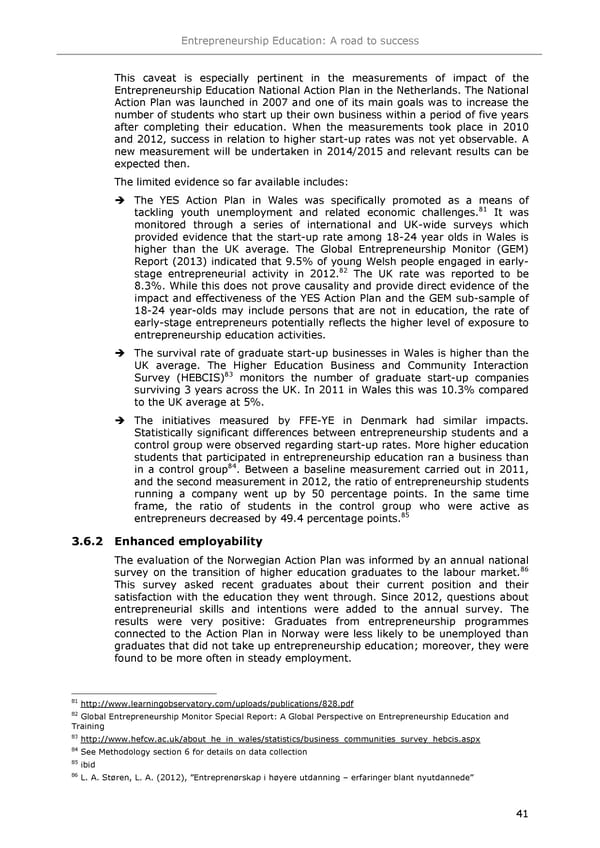Entrepreneurship Education: A road to success This caveat is especially pertinent in the measurements of impact of the Entrepreneurship Education National Action Plan in the Netherlands. The National Action Plan was launched in 2007 and one of its main goals was to increase the number of students who start up their own business within a period of five years after completing their education. When the measurements took place in 2010 and 2012, success in relation to higher start-up rates was not yet observable. A new measurement will be undertaken in 2014/2015 and relevant results can be expected then. The limited evidence so far available includes: The YES Action Plan in Wales was specifically promoted as a means of 81 tackling youth unemployment and related economic challenges. It was monitored through a series of international and UK-wide surveys which provided evidence that the start-up rate among 18-24 year olds in Wales is higher than the UK average. The Global Entrepreneurship Monitor (GEM) Report (2013) indicated that 9.5% of young Welsh people engaged in early- 82 stage entrepreneurial activity in 2012. The UK rate was reported to be 8.3%. While this does not prove causality and provide direct evidence of the impact and effectiveness of the YES Action Plan and the GEM sub-sample of 18-24 year-olds may include persons that are not in education, the rate of early-stage entrepreneurs potentially reflects the higher level of exposure to entrepreneurship education activities. The survival rate of graduate start-up businesses in Wales is higher than the UK average. The Higher Education Business and Community Interaction 83 Survey (HEBCIS) monitors the number of graduate start-up companies surviving 3 years across the UK. In 2011 in Wales this was 10.3% compared to the UK average at 5%. The initiatives measured by FFE-YE in Denmark had similar impacts. Statistically significant differences between entrepreneurship students and a control group were observed regarding start-up rates. More higher education students that participated in entrepreneurship education ran a business than 84 in a control group . Between a baseline measurement carried out in 2011, and the second measurement in 2012, the ratio of entrepreneurship students running a company went up by 50 percentage points. In the same time frame, the ratio of students in the control group who were active as 85 entrepreneurs decreased by 49.4 percentage points. 3.6.2 Enhanced employability The evaluation of the Norwegian Action Plan was informed by an annual national survey on the transition of higher education graduates to the labour market.86 This survey asked recent graduates about their current position and their satisfaction with the education they went through. Since 2012, questions about entrepreneurial skills and intentions were added to the annual survey. The results were very positive: Graduates from entrepreneurship programmes connected to the Action Plan in Norway were less likely to be unemployed than graduates that did not take up entrepreneurship education; moreover, they were found to be more often in steady employment. 81 http://www.learningobservatory.com/uploads/publications/828.pdf 82 Global Entrepreneurship Monitor Special Report: A Global Perspective on Entrepreneurship Education and Training 83 http://www.hefcw.ac.uk/about_he_in_wales/statistics/business_communities_survey_hebcis.aspx 84 See Methodology section 6 for details on data collection 85 ibid 86 L. A. Støren, L. A. (2012), =Entreprenørskap i høyere utdanning 3 erfaringer blant nyutdannede= 41
 Entrepreneurship Education Page 44 Page 46
Entrepreneurship Education Page 44 Page 46